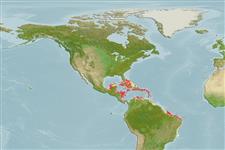Environment: milieu / climate zone / depth range / distribution range
Ecology
Marine; reef-associated. Tropical; 27°N -
Western Atlantic: Bahamas and Central America to northern South America.
Size / Weight / Age
Maturity: Lm ? range ? - ? cm
Max length : 5.0 cm TL male/unsexed; (Ref. 9710)
Dark green, with 17-23 pale green bars. Brownish stripe through eye interrupted by bright red spot.
Inhabits pitted limestone faces and tide pools in surf areas in clear waters. Usually found among spines of rock-boring sea urchins (Ref. 26938). A protogynous hermaphrodite (Ref. 55367). Has been reared in captivity (Ref. 35420).
Life cycle and mating behavior
Maturities | Reproduction | Spawnings | Egg(s) | Fecundities | Larvae
Benthic spawner. A monandric species (Ref. 55367). Sex reversal is completed in 3-5 weeks (Ref. 34185, 31410). Length at sex change = 2.0 cm TL (Ref. 55367). Males have a unique paired, secretory, accessory gonadal structures (AGS) associated with the testis (Ref. 103904).
Robins, C.R. and G.C. Ray, 1986. A field guide to Atlantic coast fishes of North America. Houghton Mifflin Company, Boston, U.S.A. 354 p. (Ref. 7251)
IUCN Red List Status (Ref. 130435)
Threat to humans
Harmless
Human uses
Fisheries: commercial; aquarium: commercial
Tools
Special reports
Download XML
Internet sources
Estimates based on models
Preferred temperature (Ref.
123201): 26.8 - 28.2, mean 27.6 °C (based on 493 cells).
Phylogenetic diversity index (Ref.
82804): PD
50 = 0.5000 [Uniqueness, from 0.5 = low to 2.0 = high].
Bayesian length-weight: a=0.00708 (0.00333 - 0.01504), b=3.09 (2.92 - 3.26), in cm total length, based on LWR estimates for this (Sub)family-body shape (Ref.
93245).
Trophic level (Ref.
69278): 3.2 ±0.3 se; based on size and trophs of closest relatives
Resilience (Ref.
120179): High, minimum population doubling time less than 15 months (Preliminary K or Fecundity.).
Fishing Vulnerability (Ref.
59153): Low vulnerability (10 of 100).
